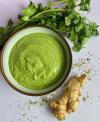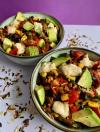
Smoothies, are they healthy or not? This is a common question I am asked, and my answer is always “it depends”. It depends on how much fruit is added, it depends on whether there is a bunch of added sugar from dates, honey, maple syrup or agave syrup and it depends on whether there is enough substance to keep you feeling full aka protein and healthy fat. There are so many different recipes out there, but really you can build your own smoothie based on the ingredients you like and have access to at home. Here are some core considerations and ingredients to keep stock of:
Start with some fruit
- Mix it up by adding in a variety of fruits - around 1/2 cup in total is a good guide
- Frozen is usually best as it helps to keep your smoothie nice and cool, but you can also used tinned fruit in juice or fresh fruit if you have it on hand
- Chopping bananas into chunks and freezing the pieces in snap lock bags means yous don’t have to worry about defrosting bananas on the bench first
- Frozen berries and mango are easy to find and go well with a piece of banana
- Smoothie mixes take the guesswork away and are already conveniently mixed for you in the bag - you can even get mixes with vegetables and herbs added now
Chuck in some veggies
- Adding in some vegetables really helps to bump up your fibre intake
- It also provides a good source of vitamins, minerals and antioxidants
- Baby spinach or kale leaves are common go tos or mix it up by adding in cavelo nero, silverbeet or lettuce
- Other great vegetable additions include celery and cucumber or root vegetables such as beetroot and carrot
- By the time you add in all your other ingredients, you’ll hardly notice the veggies are there
Consider your source of protein
- Plain yoghurt is an great source of protein but also helps to increase your calcium intake - choose one that is higher in protein if you can and add in 2-3 tablespoons
- Calci fortified milk or unsweetened soy milk provide 15g and 8g of protein per 250ml respectively
- Unfortunately almond, coconut, oat, and rice milk contain a minimal amount of protein
- If you are lactose intolerant or simply not a dairy fan, try adding in a protein powder - pea, hemp or soy can be great dairy free options and are incredibly filling
Add in some healthy fat
- A little bit of healthy fat goes a long way when it comes to the satisfaction you get from a smoothie
- Think nuts such as almonds, walnuts or cashews or seeds such as pumpkin, sunflower, chia or linseeds
- Nut butters are also an incredibly easy way to top up your healthy fat intake wheather that comes from peanut, almond or cashew butter
- 1 tablespoon of nuts, seeds or nut butter is sufficient
- If you are looking for a nut free alternative, 1/4 of an avocado can also help to make your smoothie nice and creamy
Increase your fluids
- Whether you choose to add water, coconut water or unsweetened almond milk, these options are either calorie free or low in calories
- Adding in extra fluid can be a great to top up your hydration levels if you are struggling to get enough in across the day
- Avoid adding fluids that are concentrated in sugar such as fruit juice, flavoured milks or milk alternatives or concentrated in fat such as coconut milk
Additional extras
- Spices such as cinnamon, ground ginger or nutmeg can help to make your smoothie extra tasty
- Herbs such as mint or parsley are also quite nice if you are making a green smoothie
- Freshly grated ginger or tumeric can be a great addition if you have these on hand
- Vanilla essence is always a yummy addition
- Cocoa or cacao powder can make your smoothie nice and chocolately if you are making a berry banana smoothie or banana and peanut butter combo


